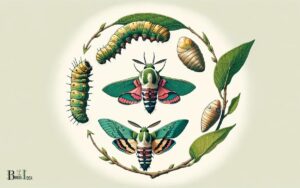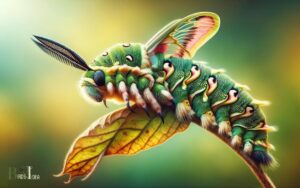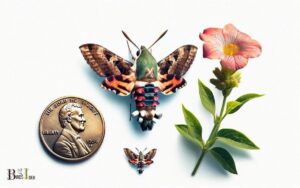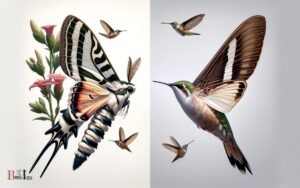Is a Hummingbird Moth a Bird or Insect? Find Out Here!
A hummingbird moth is not a bird; it is, in fact, an insect. Specifically, it belongs to the sphinx moth family (Sphingidae).
And it is commonly known as a hummingbird moth due to its remarkable resemblance to hummingbirds in both appearance and behavior.
These moths have evolved to mimic the flight patterns, rapid wing beats, and hovering abilities of hummingbirds, allowing them to feed on nectar from flowers in a similar fashion.
Despite their avian-like characteristics, a closer examination reveals the insect anatomy, with six legs, a pair of antennae, and distinctive moth-like features.
The hummingbird moth showcases the fascinating convergent evolution, where unrelated species develop similar traits to adapt to similar ecological niches.
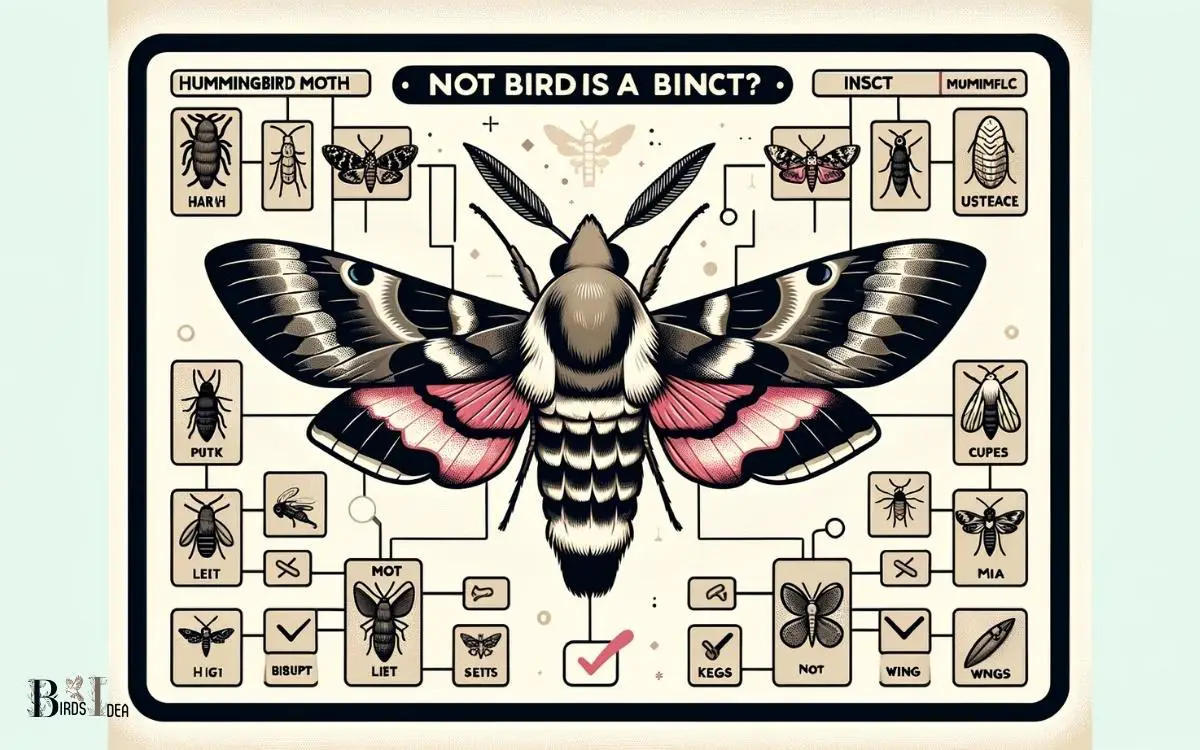
Key Takeaway
Physical Characteristics
The Hummingbird Moth possesses the physical characteristics of both a bird and an insect. Resembling a small hummingbird, it has a plump body covered in scales, large eyes, and a long proboscis for feeding on nectar.
Its wingspan can reach up to two inches, and its rapid wing movement allows it to hover and dart from flower to flower with remarkable agility.
Like an insect, it has six legs and undergoes a complete metamorphosis from egg to larva to pupa to adult.
Its ability to fly, feed, and pollinate flowers mirrors that of a bird, while its exoskeleton, antennae, and reproductive system align it with insects.
These unique physical attributes make the Hummingbird Moth a fascinating and complex creature, blurring the lines between birds and insects.
Habitat and Distribution
The geographic range and climate play a crucial role in the habitat and distribution of the hummingbird moth.
Understanding the preferred habitats and plants where these moths are commonly found is essential for comprehending their ecological niche.
Additionally, exploring their migration patterns and behavior provides valuable insights into their movement and adaptation to different environments.
Geographic Range and Climate
A hummingbird moth can be found throughout North and South America, inhabiting various climates from tropical to temperate regions.
Their geographic range and climate preferences are influenced by several factors:
- Diverse Habitats: Hummingbird moths are adaptable and can thrive in a range of environments, including forests, meadows, and gardens.
- Temperature Tolerance: They’re capable of surviving in both warm and cool climates, thanks to their ability to regulate body temperature and seek nectar from a variety of flowering plants.
- Migration Patterns: Some species exhibit seasonal migration to follow the blooming of specific plants, allowing them to adjust to changing climate conditions.
This wide distribution and adaptability enable hummingbird moths to thrive in a variety of ecosystems, contributing to their ecological significance.
Understanding their geographic range and climate preferences is crucial for conservation efforts and ecosystem management. This knowledge also sets the stage for exploring their preferred habitats and plants.
Preferred Habitats and Plants
Hummingbird moths prefer a diverse range of habitats and seek out specific flowering plants for nectar.
They’re commonly found in open areas such as meadows, gardens, and fields, where a variety of flowering plants are abundant.
These moths are particularly attracted to tubular-shaped flowers, such as honeysuckle, bee balm, and phlox, as their long proboscis allows them to reach the nectar deep within the flowers.
Additionally, they’re known to frequent areas with ample sunlight, as they rely on warmth to facilitate their flight and metabolism.
Their preference for specific nectar sources and suitable habitats influences their distribution and population dynamics.
Understanding these habitat preferences is crucial for conservation efforts and ecosystem management.
Transitioning to the subsequent section, these preferences also impact their migration patterns and behavior.
Migration Patterns and Behavior
Although small in size, the hummingbird moth’s migration patterns and behavior strongly reflect its dependence on specific habitats and nectar sources.
These remarkable creatures exhibit fascinating traits in their migration and behavior:
- Seasonal Movement: Hummingbird moths migrate to warmer regions during winter, where they can find suitable nectar sources for survival.
- Habitat Selection: They’re highly selective in choosing habitats with abundant nectar-producing plants, such as gardens, meadows, and fields, to support their energy-intensive activities.
- Territorial Behavior: Hummingbird moths often exhibit territorial behavior, defending their preferred feeding areas from other insects and even hummingbirds.
Understanding these migration patterns and behaviors is crucial in conservation efforts to ensure the availability of suitable habitats and nectar sources for these remarkable insects.
This knowledge aids in preserving their populations and maintaining ecological balance. Transitioning into the subsequent section about ‘feeding behavior’, these migration patterns greatly influence their feeding habits.
Feeding Behavior
The feeding behavior of the hummingbird moth centers around its primary food source, nectar.
These moths have a unique hovering and sipping technique, which allows them to extract nectar from flowers while in flight.
Their long proboscis enables them to reach deep into flowers to access the sweet liquid, making them efficient pollinators in the process.
Nectar as Primary Food
It prefers to feed on nectar from a variety of flowers, making it a vital pollinator in its ecosystem.
Hummingbird moths have a specialized feeding behavior that allows them to efficiently obtain nectar as their primary food source.
This behavior involves several key aspects:
- Long proboscis: The moth possesses a long, straw-like proboscis that allows it to reach deep into flowers to extract nectar.
- Rapid wing movement: The rapid fluttering of its wings enables the moth to hover in front of flowers while feeding.
- Precision in flight: Hummingbird moths demonstrate remarkable agility and precision in flight, allowing them to navigate through complex floral structures with ease.
These adaptations enable the moth to effectively obtain nectar, fulfilling its nutritional needs while simultaneously serving as an essential pollinator in its environment.
This feeding behavior is a fascinating aspect of the hummingbird moth’s ecological role, closely linked to its remarkable physical capabilities.
This feeding behavior is closely tied to its unique ability to hover and sip nectar, which will be discussed in the subsequent section.
Hovering and Sipping
With its rapid wing movement and long proboscis, a hummingbird moth hovers and sips nectar from flowers, displaying remarkable agility and precision in flight.
This behavior allows the moth to access the nectar hidden within the depths of tubular flowers.
As the moth hovers in front of the flower, its long proboscis extends to reach the nectar while the wings beat rapidly to maintain its position. The proboscis acts like a straw, drawing the nectar into its mouth for consumption.
This feeding behavior requires intricate coordination between the moth’s sensory systems, wing muscles, and proboscis to ensure successful nectar retrieval.
The hummingbird moth’s ability to hover and sip nectar with such dexterity is a fascinating adaptation that allows it to thrive in its ecological niche.
Life Cycle and Reproduction
The hummingbird moth undergoes a complete metamorphosis, progressing through egg, larva, pupa, and adult stages during its life cycle.
After mating, the female moth lays tiny, round, pale-green eggs on the underside of host plant leaves.
These eggs hatch into larvae, commonly known as caterpillars, which then feed voraciously on the leaves of the host plant.
As they grow, the caterpillars molt several times before entering the pupa stage. Inside the pupa, the caterpillar undergoes a remarkable transformation, eventually emerging as an adult hummingbird moth.
The adult moth then repeats the cycle by finding a mate and laying eggs, thus continuing the life cycle.
- Egg stage: The female moth lays pale-green eggs on the underside of host plant leaves.
- Larva stage: The hatched larvae, or caterpillars, feed on the leaves of the host plant.
- Pupa stage: The caterpillar enters the pupa stage, undergoing a remarkable transformation.
Similarities to Hummingbirds
While resembling hummingbirds in appearance and behavior, the hummingbird moth is an insect known for its unique flight patterns and feeding habits.
Like hummingbirds, these moths have long, narrow bodies and are often mistaken for their avian counterparts due to their hovering flight and ability to extract nectar from flowers while in mid-air.
Both species are also diurnal, being most active during the day, and are known for their rapid wingbeats, allowing them to remain stationary in the air while feeding.
Additionally, both hummingbirds and hummingbird moths play important roles in pollination, transferring pollen from one flower to another as they feed.
These similarities demonstrate convergent evolution, where unrelated species evolve similar traits due to similar ecological roles and selective pressures.
Key Differences From Birds
Despite their similarities to hummingbirds, the hummingbird moth is distinctly different from birds in several key ways.
- Physical Characteristics: Hummingbird moths have a sleek body with clear wings, while birds have feathers and wings.
- Life Cycle: Hummingbird moths undergo a complete metamorphosis, with egg, larva, pupa, and adult stages, whereas birds hatch from eggs and go through a process of growing feathers and reaching maturity.
- Dietary Habits: Hummingbird moths feed on nectar from flowers using a long proboscis, while birds consume a diverse diet including seeds, insects, and other animals.
These differences highlight the biological distinctions between hummingbird moths and birds, emphasizing the importance of understanding the unique characteristics of each species for accurate classification and ecological studies.
Predators and Threats
Hummingbird moths face predators and threats from various species due to their resemblance to hummingbirds and their unique ecological niche as nectar-feeding insects.
Birds such as sparrows, warblers, and swifts are known predators of hummingbird moths, mistaking them for actual hummingbirds.
Additionally, spiders, mantises, and other predatory insects pose a threat to hummingbird moths when they’re in their vulnerable caterpillar or pupal stages.
Parasitic wasps are also a significant threat, laying their eggs inside the moth’s caterpillars, which ultimately leads to their demise.
Environmental factors such as habitat loss, pesticide use, and climate change further exacerbate the threats faced by hummingbird moths, impacting their food sources and survival.
Understanding these predators and threats is crucial for the conservation of these fascinating creatures.
Is a Hummingbird Moth a Rare Sight or Common in Certain Areas?
The sight of a hummingbird moth may seem rare to some, but in certain areas, they are quite common. The hummingbird moth symbolism meanings often represent transformation and agility. These creatures can be spotted in gardens, fields, and forests, where they gracefully flutter from flower to flower, resembling their namesake.
Conservation Status
How extensively is the conservation status of the hummingbird moth being monitored and addressed by environmental organizations and researchers?
The conservation status of the hummingbird moth is actively monitored and addressed by various environmental organizations and researchers.
Efforts are made to understand the population trends, habitat requirements, and potential threats to this species.
Conservation programs are also being implemented to protect the natural habitats of the hummingbird moth and to raise awareness about its importance in the ecosystem.
- Population Monitoring: Researchers are conducting regular surveys and monitoring programs to assess the population trends of the hummingbird moth.
- Habitat Protection: Environmental organizations are working to conserve and restore the natural habitats of the hummingbird moth, including native plants crucial for its survival.
- Public Awareness: Conservation efforts include educational initiatives to raise public awareness about the significance of the hummingbird moth and its conservation needs.
Conclusion
The hummingbird moth is often mistaken for a bird due to its similar appearance and feeding behavior.
Interestingly, these fascinating insects are known to beat their wings at an incredible speed of up to 70 beats per second, allowing them to hover and feed on nectar much like their avian counterparts.
This unique characteristic makes them a truly remarkable and impressive species in the insect world.


